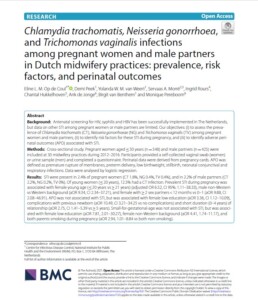Research highlights: STIs in pregnant women in Dutch midwifery practices
Research highlights: STIs in pregnant women in Dutch midwifery practices
In the Netherlands, pregnant women are routinely screened for HIV, syphilis and hepatitis B. But what about other common STIs such as chlamydia, gonorrhoea and trichomonas in pregnant women? Researchers in 30 Dutch obstetric practices, 548 pregnant women and 425 male partners were asked to undergo a soa test and to complete a questionnaire. They also collected data on the pregnancy from the pregnant woman's file.
Risk factors
In the end, 2.4% of the pregnant women and 2.2% of the male partners had a positive result of the soatest. Chlamydia infections were the most common. Women were more likely to have a positive result if they were younger than 20 years old, had a male partner from a non-Western background or had had more than two sexual partners in the previous 12 months. In the group of pregnant women up to 20 years old, chlamydia infection was even diagnosed in 12.5%.
No correlation negative pregnancy outcomes
This study found no correlation between a positive soatest and negative pregnancy outcomes such as premature rupture of membranes, preterm birth, low birth weight, stillbirth, eye infection or pneumonia in the baby. Other studies do show this correlation. The authors indicate that this is probably due to the smaller group size.
Negative consequences of undetected STIs
International guidelines recommend screening for chlamydia in all pregnant women under the age of 25. Dutch midwives base their advice to test more on the presence of symptoms rather than risk factors.1 Nevertheless, it is good to be alert for STI risk in pregnant women. Undetected STIs can have negative consequences for the woman such as PID, infertility or a higher risk of ectopic pregnancy.2
Prevalence of STIs in other studies
Another study in Rotterdam showed a prevalence of 3.9% chlamydia in pregnant women up to 30 years of age.3 According to the World Health Organisation (WHO), the prevalence of STIs in women aged 15-49 in Europe is estimated at 2.2% for chlamydia, 0.3% for gonorrhoea and 0.1% for trichomonas.4 Thus, the prevalence of STIs does not appear to be lower for pregnant women than for non-pregnant women.
Soar risk and coil placement postpartum
If women wish to have an IUD postpartum, it is important to rule out an STI during IUD placement to avoid the risk of PID.5 If there are no symptoms, a soak test can be done in the same consultation as the IUD placement.6 If the result is still positive, the STI can be treated with the IUD in situ. If there is no improvement after 72 hours, removal of the coil can be considered.5
As a midwife practice, do you stock a soatest? Order (self) test in the webshop or via the Contraception portal.
References
- Op de Coul, E.L.M., Peek, D., van Weert, Y.W.M. et al.Chlamydia trachomatis, Neisseria gonorrhoea, and Trichomonas vaginalis Infections among pregnant women and male partners in Dutch midwifery practices: prevalence, risk factors, and perinatal outcomes. Reprod Health 18, 132 (2021). https://doi.org/10.1186/s12978-021-01179-8
- NHG Standard PID https://richtlijnen.nhg.org/standaarden/pelvic-inflammatory-disease
- Rours GI, Duijts L, Moll HA, Arends LR, de Groot R, Jaddoe VW, et al. Chlamydia trachomatis infection during pregnancy associated with preterm delivery: a population-based prospective cohort study. Eur J Epidemiol. 2011;26(6):493-502.
- Newman L, Rowley J, Vander Hoorn S, Wijesooriya NS, Unemo M, Low N, et al. Global estimates of the prevalence and incidence of four curable sexually transmitted infections in 2012 based on systematic review and global reporting. PLoS ONE. 2015;10(12): e0143304.
- NHG Standard Contraception (last consulted on 04-08-2022) https://richtlijnen.nhg.org/standaarden/anticonceptie#volledige-tekst
- H&W. Screening for STIs during coil insertion https://www.henw.org/system/files/download/HW58-664.pdf

Share via social media

